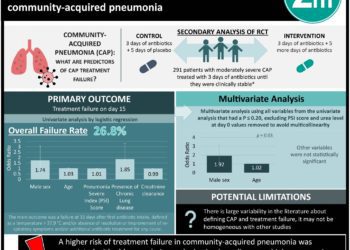Features predicting treatment failure in acute otitis media
1. In this study of children with acute otitis media randomized into treatment and placebo groups, older children were less likely to fail treatment, as well as those with peaked tympanograms.
2. Children with severe bulging tympanic membranes were more likely to experience treatment failure.
Evidence Rating Level: 1 (Excellent)
Study Rundown: Acute otitis media (AOM) is the most common childhood bacterial infection. Despite stringent diagnostic and treatment criteria set forth by the American Academy of Pediatrics (AAP), about half of AOM cases resolve without antibiotic treatment. In order to encourage better antibiotic stewardship, this study attempted to identify features that may warrant close observation rather than antibiotic treatment of AOM. Children in primary care settings were randomized to receive placebo or amoxicillin-clavulanate for 7 days, and time until treatment failure was tracked. Children with peaked tympanogram at the time of enrollment were less likely to fail treatment. Severe bulging of the tympanic membrane almost doubled the treatment failure hazard ratio (HR) in the placebo group, while severe bulging had no effect on outcome in the treatment group. One in 5 children experienced treatment failure in the antimicrobial group, while almost half of children experienced treatment failure in the placebo group. The children who benefited most from treatment were those with severe bulging of the tympanic membrane at enrollment. Clinicians can utilize study findings to practice improved antibiotic stewardship. While this study highlights objective clinical findings that increase risk of treatment failure, generalizability of results are limited due to the single geographic location of study participants.
Click to read the study published today in Pediatrics
Relevant Reading: Shortened antimicrobial treatment for acute otitis media in young children
Study Author, Paula Tahtinen, MD, PhD, talks to 2 Minute Medicine: Turku University Hospital, Department of Paediatrics and Adolescent Medicine, Turku, Finland.
“Our results emphasize the importance of accurate diagnosis of AOM; children with severe bulging of the tympanic membrane seem to benefit most from antimicrobial treatment. Clinicians can use these results in their every-day practice when discussing the treatment decisions with the parents.”
In-Depth [prospective cohort]: This study included 319 children (158 in placebo group) ages 6 to 35 months, from 5 pediatric primary care practices in Finland, recruited from March 2006 to December 2008. At initial visits, pneumatic otoscopy was performed. Children were then randomized to treatment or placebo groups. At follow up, treatment failure was assessed. Treatment failure was defined as any of the following: no improvement in overall condition by day 3, worsening of condition, no improvement on otoscopy by day 8, perforation of tympanic membrane, development of severe infection, or any reason to discontinue study drug at any time. Treatment failure across both groups occurred in 31.7% of patients (101/319), 18.6% failure rate in the treatment group and 44.9% failure rate in the placebo group. Children 24 to 35 months of age had lower treatment failure than those 6 to 23 months old (20% vs. 34.4%). Peaked tympanogram at the time of study enrollment decreased the risk for treatment failure (14% vs. 35.5%). Children with severe bulging of the tympanic membrane had the greatest difference in treatment failure between the treatment and placebo groups (11.1% vs. 64.1%, respectively, rate difference -53%, 95%CI -73.5% to -32.4%). If a child with bulging tympanic membrane received treatment, this feature did not affect the risk of treatment failure (HR = 0.51, 95%CI 0.2-1.34, p = .17).
Image: PD
©2017 2 Minute Medicine, Inc. All rights reserved. No works may be reproduced without expressed written consent from 2 Minute Medicine, Inc. Inquire about licensing here. No article should be construed as medical advice and is not intended as such by the authors or by 2 Minute Medicine, Inc.

![The ABCD2 score: Risk of stroke after Transient Ischemic Attack (TIA) [Classics Series]](https://www.2minutemedicine.com/wp-content/uploads/2013/05/web-cover-classics-with-logo-medicine-BW-small-jpg-350x250.jpg)





